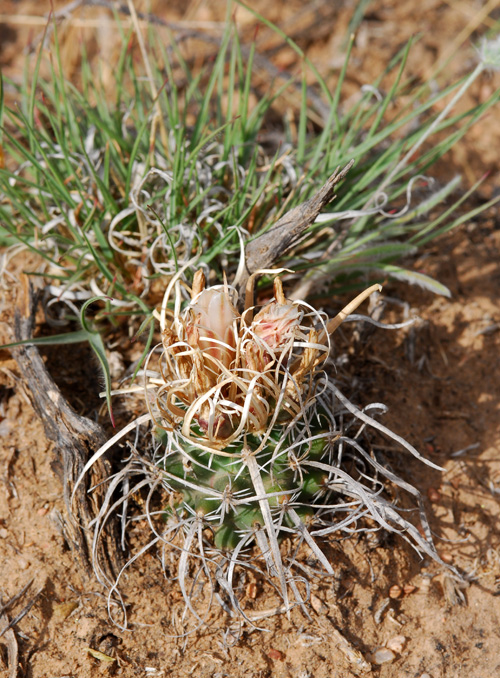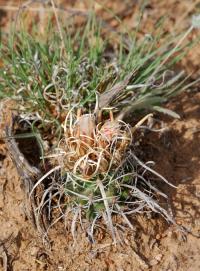Stems unbranched, cylindric or obconic cylindric, 2-7.5(-8) × 1.2-2.5 cm; ribs not evident, tubercles prominent. Spines dense, obscuring stems; radial spines 5-10 per areole, white, straight, flat, (2-)3-5 × 0.3-0.6 mm; central spines 1(-4) per areole; abaxial central spine 1 per areole, whitish to tan or gray, straight, wavy, twisting, or curling, flat, flexible, papery, with obscure adaxial midrib, sometimes pointing upward and obscuring apex of plant, lacking hook, 15-45(-50) × 1-1.5 mm; lateral or adaxial central spines 0(-3) per areole, white to tan, (3-)20-40 × 0.5-1 mm. Flowers funnelform to narrowly campanulate, 2-2.5 × 1-2.5 cm; outer tepals with green-purple to red-brown midstripes and cream to white margins, cuneate-spatulate, usually 9-20 × 1-3 mm, finely toothed; inner tepals white with brown midstripes, largest tepals oblanceolate, 15-20 × 3.5-4.5 mm, apex acute to mucronate; filaments white to greenish yellow; anthers cream to pale yellow. Fruits indehiscent or irregularly dehiscent, green, subspheric, 4-6 × 3-5 mm, dry at maturity; scales few or none. Seeds black, 2.5-3 × 2-2.5 mm, shiny; testa with fine, rounded papillae.
Flowering Apr-Jun. Desert grasslands, pinyon-juniper woodlands, Chihuahuan desert scrub; 1500-2200 m; Ariz., N.Mex., Tex.
With long, flexuous, flattened spines and pale flowers, Sclerocactus papyracanthus is surprisingly cryptic in the field. There has been a long debate concerning its taxonomic placement. Chloroplast DNA analyses of J. M. Porter et al. (2000) unambiguously placed this species within Sclerocactus, a position first suggested based on morphologic evidence (K. D. Heil et al. 1981; C. Glass and R. A. Foster 1984).
Plant: STEMS solitary, cylindrical, 2.5-10 cm long, 1.2-2.5 cm in diameter; tubercles elongate-mammillate to elongate-conical, 3-5 mm long and broad, spirally arranged
Leaves: SPINES more or less obscuring the stem; central spines (0-)1(-4), upper ones smaller, curving upward, 2-3 cm long, 1-1.5 mm at the base, white, pale brown, changing to gray, flexible, strongly flattened, the midrib evident on adaxial side; radial spines 6-8 spreading, flexible, the longest up to 3.5 cm long, 0.5 mm broad, flat, thin, white to pale gray
Flowers: at apex of stem, 2-2.5 cm long, 2-2.5 cm wide; outer tepals spatulate, to 20 mm long, 2.5-3 mm broad, scarious, with a few irregular marginal teeth, purple to reddish-brown midribs and white margins; inner tepals oblanceolate, 15-20 mm long, up to 4.5 mm broad, mucronate, entire, white; filaments white, the anthers pale yellow; style green; stigma lobes 5
Fruit: FRUITS 4-6.5 mm long, to 4.5 mm in diameter, dry at maturity, green, changing to tan with a few or no scales, subglobose, ovary wall thin, dehiscing irregularly when dry. SEEDS to 2.5 mm long, 3 mm broad, 1 mm thick, black, papillate-tessellate
Misc: Grassland and pinyon-juniper woodland communities, especially in sandy soils; 1500-2200 m (5000-7200 ft);; May
REFERENCES: Heil, Kenneth D., and Mark J. Porter. 2001. Cactaceae. J. Ariz. - Nev. Acad. Sci. Volume 33(1).
Duration: Perennial
General: Solitary-stemmed hedgehog-type cactus; stems cylindrical, 3-10 cm tall and 1-2.5 cm in diameter; ribs not evident, but tubercles prominent and spirally-arranged, 3-5 mm long and broad.
Spines: Spines more or less obscuring the stem; central spines usually 1 per areole, strongly flattened, flexible, and curving upward, 2-3 cm long, and 1-1.5 mm wide at the base, white or pale brown, aging to gray; radial spines (spines emerging from the outside edge of the areole) 6-8 per areole, flat and thin, spreading, and flexible, the longest up to 3.5 cm long, 0.5 mm broad, white to pale gray.
Flowers: Located at the apex of stems, flowers are 2-3 cm long and about as wide; petals numerous; outer petals spatulate, to 2 cm long and 3 mm wide, scarious (thin and papery) with a few irregular marginal teeth, white with purple to reddish-brown midribs; inner petals oblanceolate, 2 cm long and up to 5 mm broad, with small pointed tips, white; filaments numerous, white, topped with pale yellow anthers; style green, topped with a ring of 5 stigma lobes.
Fruits: Fruits dry and thin-walled when mature, subglobose, 5 mm long, green when developing, drying to a a tan color, and dehiscing (splitting open) irregularly; seeds 3 mm wide, black.
Ecology: Found in grasslands and pinyon-juniper woodland communities, especially in sandy soils, from 5,000-7,500 ft (1524-2286 m); flowers in May.
Distribution: e AZ, NM, w TX
Ethnobotany: Unknown
Etymology: Sclerocactus from the Greek sclerao, cruel or obstinate, referring to the hooked spines; papyracanthus comes from papyrus, the original paper made in ancient Egypt, and acantha, or spine, alluding to the spines resembling curls of paper.
Editor: AHazelton 2017




